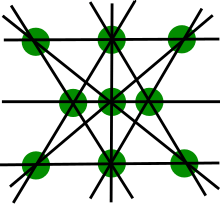Orchard-planting problem
In discrete geometry, the original orchard-planting problem asks for the maximum number of 3-point lines attainable by a configuration of points in the plane. It is also called the tree-planting problem or simply the orchard problem. There are also investigations into how many k-point lines there can be. Hallard T. Croft and Paul Erdős proved tk > c n2 / k3, where n is the number of points and tk is the number of k-point lines.[1] Their construction contains some m-point lines, where m > k. One can also ask the question if these are not allowed.

Integer sequence
Define t3orchard(n) to be the maximum number of 3-point lines attainable with a configuration of n points. For an arbitrary number of points, n, t3orchard(n) was shown to be (1/6)n2 − O(n) in 1974.
The first few values of t3orchard(n) are given in the following table (sequence A003035 in the OEIS).
| n | 4 | 5 | 6 | 7 | 8 | 9 | 10 | 11 | 12 | 13 | 14 |
|---|---|---|---|---|---|---|---|---|---|---|---|
| t3orchard(n) | 1 | 2 | 4 | 6 | 7 | 10 | 12 | 16 | 19 | 22 | 26 |
Upper and lower bounds
Since no two lines may share two distinct points, a trivial upper-bound for the number of 3-point lines determined by n points is
Using the fact that the number of 2-point lines is at least 6n/13 (Csima & Sawyer 1993), this upper bound can be lowered to
Lower bounds for t3orchard(n) are given by constructions for sets of points with many 3-point lines. The earliest quadratic lower bound of ~(1/8)n2 was given by Sylvester, who placed n points on the cubic curve y = x3. This was improved to [(1/6)n2 − (1/2)n] + 1 in 1974 by Burr, Grünbaum, and Sloane (1974), using a construction based on Weierstrass's elliptic functions. An elementary construction using hypocycloids was found by Füredi & Palásti (1984) achieving the same lower bound.
In September 2013, Ben Green and Terence Tao published a paper in which they prove that for all point sets of sufficient size, n > n0, there are at most ([n(n - 3)/6] + 1) = [(1/6)n2 − (1/2)n + 1] 3-point lines which matches the lower bound established by Burr, Grünbaum and Sloane.[2] This is slightly better than the bound that would directly follow from their tight lower bound of n/2 for the number of 2-point lines: [n(n − 2)/6], proved in the same paper and solving a 1951 problem posed independently by Gabriel Andrew Dirac and Theodore Motzkin.
Notes
- The Handbook of Combinatorics, edited by László Lovász, Ron Graham, et al, in the chapter titled Extremal Problems in Combinatorial Geometry by Paul Erdős and George B. Purdy.
- Green & Tao (2013)
References
- Brass, P.; Moser, W. O. J.; Pach, J. (2005), Research Problems in Discrete Geometry, Springer-Verlag, ISBN 0-387-23815-8.
- Burr, S. A.; Grünbaum, B.; Sloane, N. J. A. (1974), "The Orchard problem", Geometriae Dedicata, 2 (4): 397–424, doi:10.1007/BF00147569.
- Csima, J.; Sawyer, E. (1993), "There exist 6n/13 ordinary points", Discrete and Computational Geometry, 9: 187–202, doi:10.1007/BF02189318.
- Füredi, Z.; Palásti, I. (1984), "Arrangements of lines with a large number of triangles", Proceedings of the American Mathematical Society, 92 (4): 561–566, doi:10.2307/2045427, JSTOR 2045427.
- Green, Ben; Tao, Terence (2013), "On sets defining few ordinary lines", Discrete and Computational Geometry, 50 (2): 409–468, arXiv:1208.4714, doi:10.1007/s00454-013-9518-9